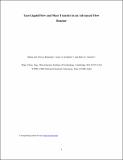Gas–Liquid Flow and Mass Transfer in an Advanced-Flow Reactor
Author(s)
Nieves-Remacha, Maria Jose; Kulkarni, Amol A.; Jensen, Klavs F.
DownloadJensen_Gas-liquid flow with SI.pdf (3.306Mb)
OPEN_ACCESS_POLICY
Open Access Policy
Creative Commons Attribution-Noncommercial-Share Alike
Terms of use
Metadata
Show full item recordAbstract
Hydrodynamics and mass transfer of gas–liquid flow are explored under ambient conditions in an Advanced-Flow Reactor (AFR), an emerging commercial system designed for continuous manufacture. Carbon dioxide/water is the model system used in this study for a range of flow rates for gas and liquid of 5.6–103 mL/min and 10–80 mL/min, respectively. Bubble size distribution, gas holdup, specific interfacial area, pressure drop, and mass transfer coefficients are determined from flow visualization experiments and compared with conventional gas–liquid contactors. These variables are mainly influenced by the inlet flow rates and inlet composition. Average bubble sizes ([bar over d][subscript s]) of 0.9–3.8 mm, gas holdup (ε[subscript G]) of 0.04–0.68, specific interfacial areas (a) of 160–1300 m[superscript 2]/m[superscript 3], and overall mass transfer coefficients (k[subscript L]a) of 0.2–3 s[superscript –1] were obtained for the vertical orientation of the AFR. Although effect of gravity is present for this system, no significant effect on the hydrodynamic properties was observed. The measured pressure drop for vertical orientation (3.6–53.4 kPa) was used to estimate power consumption, which is used as a metric to compare mass transfer efficiency among different gas–liquid contactors. A power law relationship was obtained for the overall mass transfer coefficients in terms of power input and gas holdup, given by k[subscript L]a = 0.101P[0.443 over w]ε[0.459 over G]. The design of the AFR with a series of heart-shaped confined sections with obstacles enhances continuous breakup and coalescence of bubbles providing interfacial areas and mass transfer coefficients 1 order of magnitude larger than other gas–liquid contactors, such as bubble columns (50–600 m[superscript 2]/m[superscript 3]; 0.005–0.24 s[superscript –1]) and spray columns (75–170 m[superscript 2]/m[superscript 3]; 0.015–0.022 s[superscript –1]), and 1 order of magnitude smaller than gas–liquid microchannels (3400–9000 m[superscript 2]/m[superscript 3]; 0.3–21 s[superscript –1]) or falling film reactors (20,000 m[superscript 2]/m[superscript 3]).
Date issued
2013-05Department
Massachusetts Institute of Technology. Department of Chemical EngineeringJournal
Industrial & Engineering Chemistry Research
Publisher
American Chemical Society (ACS)
Citation
Nieves-Remacha, Maria Jose, Amol A. Kulkarni, and Klavs F. Jensen. “Gas–Liquid Flow and Mass Transfer in an Advanced-Flow Reactor.” Ind. Eng. Chem. Res. 52, no. 26 (July 3, 2013): 8996–9010.
Version: Author's final manuscript
ISSN
0888-5885
1520-5045